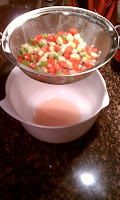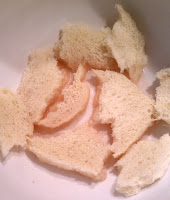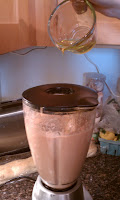There are two kinds of polenta in life. Creamy polenta, like grits, should collapse when ladled directly on a plate. Firm polenta is usually served shaped and is often fried to crisp the top and bottom. These would be the latter kind. From Thomas Keller's French Laundry cookbook, these polenta cakes are the kind of thing I usually think of as a restaurant dish, but it turns out are perfectly accessible and manageable to make in the home, especially for company.
This polenta cake recipe we paired with TK's fantastic short ribs, and the very rich sauce and very rich polenta really gave a wonderful restaurant quality feel. Although not a weekday item, they make a decent company side, because you have to chill them down and wait, and preparing things ahead is the key to successful dinner parties. You can even pre-cut the circles using a biscuit cutter, cookie cutter, or baking round, put them on a plate, and then just fire them up on the stove a few minutes before serving. And since the nature of the recipe kinda forces you to make a lot (you have to harden the polenta in a baking dish prior to cutting the cakes, and baking dishes can only be so small), it makes sense for guests, or to make some for now, and save the rest for a second meal later.
If you're not like me and don't have things like mascarpone cheese on hand (shocking, I know), you can try substituting equal parts cream cheese and sour cream. All this being said, just like sour cream is just not the same as creme fraiche (though easily substitutable for), nothing is truly like mascarpone. Just make sure to adjust any necessary firming times. Make sure to use regular polenta, not instant polenta. Extra fine polenta that is low in starch and has not been processed is also useable and will speed up your cooking time.
Polenta Cakes
2 1/2 cups chicken stock
3 cups water
1/2 teaspoon minced garlic
1 1/2 cups polenta
8 tablespoons unsalted butter, at room temperature
2 tablespoons marscapone
2 tablespoons minced chives
Kosher salt and freshly ground pepper
Flour
- Bring the chicken stock, water, and garlic to a boil in a saucepan.
- Whisking constantly, pour in the polenta.
- Return the liquid to a simmer and cook the polenta over very low heat, stirring occasionally, for 25 to 35 minutes, or until the polenta is thick and smooth.
- When the polenta is cooked, stir in the marscapone, butter, chives, and salt and pepper to taste.
- Spread the polenta in a 9 x 13 inch baking pan. Let it cool to room temperature.
- Once cooled, cover the surface of the polenta directly with plastic wrap to seal off air and refrigerate. Allow plenty of time for the polenta to fully firm up (at least three hours).
- With a 2-inch round cutter or biscuit cutter (or similar size), cut 8 rounds into the firm polenta.
- Heat about 1/8" of canola or vegetable oil in any ovenproof skillet to medium heat.
- Add some flour to a round cake pan and gently coat the pieces of polenta with flour. Shake off any excess.
- Add floured polenta round to the skillet and cook for 2-3 minutes on each side (until evenly browned on both sides and hot. If they brown too quickly (before the center is hot), the pan can be placed in a 350 degree oven to finish cooking.
- Serve warm. Any leftover polenta can be saved for three days.


















